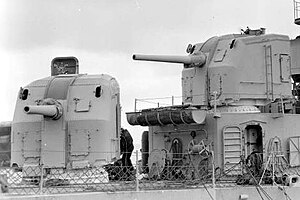| 5"/38 caliber gun | |
|---|---|
 Two Mk 30 single enclosed base ring mounts on USS David W. Taylor | |
| Type | Deck gun |
| Place of origin | United States |
| Service history | |
| In service | 1934–2008 |
| Used by | United States Navy, United States Coast Guard, Royal Navy, Danish Navy, Italian Navy, Japan Maritime Self-Defense Force, South Vietnamese Navy, and every navy that bought surplus World War II, US Navy warships |
| Wars | World War II, Korean War, Vietnam War, Gulf War, Falklands War, and wars that involved navies who bought surplus World War II, US Navy warships |
| Production history | |
| Designed | 1931–1932 |
| Specifications | |
| Mass | Mk 12 Gun Assembly: 3,990 lb (1,810 kg). Mounts varied from 29,260 lb (13,270 kg) to 170,653 lb (77,407 kg) |
| Length | Mk 12 Gun Assembly: 223.8 in (5.68 m) |
| Barrel length | 190 in (4.83 m) bore, 157.2 in (3.99 m) rifling |
| Crew | Varied on mount type |
| Shell | 127×680mmR[1] 53 to 55 lb (24 to 25 kg) |
| Caliber | 5 in (127 mm) |
| Breech | Vertical sliding-wedge |
| Recoil | 15 in (38 cm) |
| Elevation | −15° to +85° |
| Traverse | 328.5 degrees |
| Rate of fire | Design: 15 rpm |
| Muzzle velocity | 2,600 ft/s (790 m/s) initial |
| Sights | Optical telescope |
The Mark 12 5"/38-caliber gun was a United States dual-purpose naval gun, but also installed in single-purpose mounts on a handful of ships. The 38-caliber barrel was a mid-length compromise between the previous United States standard 5"/51 low-angle gun and 5"/25 anti-aircraft gun. United States naval gun terminology indicates the gun fired a projectile 5 inches (127 mm) in diameter, and the barrel was 38 calibers long. The increased barrel length provided greatly improved performance in both anti-aircraft and anti-surface roles compared to the 5"/25 gun. However, except for the barrel length and the use of semi-fixed ammunition, the 5"/38 gun was derived from the 5"/25 gun. Both weapons had power ramming, which enabled rapid fire at high angles against aircraft. The 5"/38 entered service on USS Farragut, commissioned in 1934, the first new destroyer design since the last Clemson was built in 1922. The base ring mount, which improved the effective rate of fire, entered service on USS Porter, commissioned in 1936.[2][3]
Among naval historians, the 5"/38 gun is considered the best intermediate-caliber,[4] dual purpose naval gun of World War II,[5] especially as it was usually under the control of the advanced Mark 37 Gun Fire Control System which provided accurate and timely firing against surface and air targets. Even this advanced system required nearly 1000 rounds of ammunition expenditure per aircraft kill.[6] However, the planes were normally killed by shell fragments and not direct hits; barrage fire was used, with many guns firing in the air at the same time. This would result in large walls of shell fragments being put up to take out one or several planes or in anticipation of an unseen plane, this being justifiable as one plane was capable of significant destruction. The comparatively high rate of fire for a gun of its caliber earned it an enviable reputation, particularly as an anti-aircraft weapon, in which role it was commonly employed by United States Navy vessels. Base ring mounts with integral hoists had a nominal rate of fire of 15 rounds per minute per barrel; however, with a well-trained crew, 22 rounds per minute per barrel was possible for short periods.[5] On pedestal and other mounts lacking integral hoists, 12 to 15 rounds per minute was the rate of fire.[7] Useful life expectancy was 4600 effective full charges (EFC) per barrel.[8]
The 5"/38 cal gun was mounted on a very large number of US Navy ships in the World War II era. It was backfitted to many of the World War I-era battleships during their wartime refits, usually replacing 5"/25 guns that were fitted in the 1930s. It has left active US Navy service, but it is still on mothballed ships of the United States Navy reserve fleets. It is also used by a number of nations who bought or were given US Navy surplus ships. Millions of rounds of ammunition were produced for these guns, with over 720,000 rounds still remaining in Navy storage depots in the mid-1980s because of the large number of Reserve Fleet ships with 5"/38 cal guns on board.
- ^ "106". Archived from the original on 7 December 2021. Retrieved 13 October 2022.
- ^ DiGiulian, Tony (February 2013). "United States of America 5"/38 (12.7 cm) Mark 12". navweaps.com. Retrieved 2 March 2018.
- ^ Gridley (June 1937) marks the introduction of the base ring mount in the main line of destroyers. The last 2 Mahan class ships also had them, Dunlap was commissioned in June 1937, too. Porter entered service much sooner
- ^ a Bore diameter greater than 4 inches (102 mm) and less than 8 inches (203 mm).
- ^ Naval Weapons of WW2, Campbell, P106
- ^ DiGiulian, Tony (November 2006). "United States of America 5"/38 (127 mm) Mark 12". navweaps.com. Retrieved 2 March 2018.
Pedestal and other mounts lacking integral hoists: 12 – 15 rounds per minute
- ^ Naval Weapons of WW2, Campbell, P139